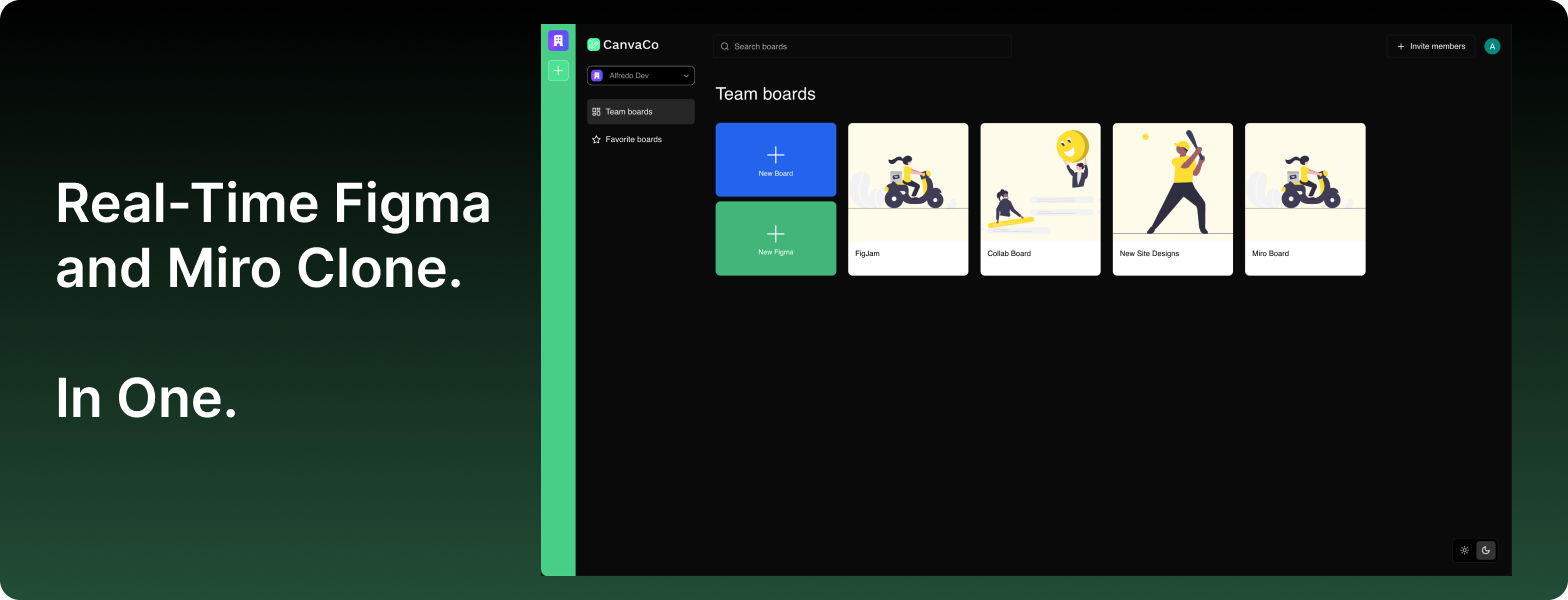- 🤖 Introduction
- ⚙️ Tech Stack
- 🔋 Features
- 🤸 Quick Start
A minimalistic Figma and Miro clone to show how to add real-world features like live collaboration with cursor chat, comments, reactions, and drawing designs (shapes, image upload) on the canvas using fabric.js. Users can create organizations and have multiple boards for each anf they can add collaborators to their organizations.
- Next.js
- TypeScript
- Convex
- Clerk
- Liveblocks
- Fabric.js
- Shadcn
- Tailwind CSS
👉 Authentication and Organization Management: Clerk implementation with sign-in and sign-up pages along with management for each organization.
👉 Multiple Boards, Multiple Styles: Allows for multiple boards each under different organizations with Figma-style and Miro-style boards.
👉 Multi Cursors, Cursor Chat, and Reactions: Allows multiple users to collaborate simultaneously by showing individual cursors, enabling real-time chat, and reactions for interactive communication.
👉 Active Users: Displays a list of currently active users in the collaborative environment, providing visibility into who is currently engaged.
👉 Comment Bubbles: Enables users to attach comments to specific elements on the canvas, fostering communication and feedback on design components.
👉 Creating Different Shapes: Provides tools for users to generate a variety of shapes on the canvas, allowing for diverse design elements
👉 Uploading Images: Import images onto the canvas, expanding the range of visual content in the design
👉 Customization: Allows users to adjust the properties of design elements, offering flexibility in customizing and fine-tuning visual components
👉 Freeform Drawing: Enables users to draw freely on the canvas, promoting artistic expression and creative design.
👉 Undo/Redo: Provides the ability to reverse (undo) or restore (redo) previous actions, offering flexibility in design decision-making
👉 Keyboard Actions: Allows users to utilize keyboard shortcuts for various actions, including copying, pasting, deleting, and triggering shortcuts for features like opening cursor chat, reactions, and more, enhancing efficiency and accessibility.
👉 History: Review the chronological history of actions and changes made on the canvas, aiding in project management and version control.
👉 Deleting, Scaling, Moving, Clearing, Exporting Canvas: Offers a range of functions for managing design elements, including deletion, scaling, moving, clearing the canvas, and exporting the final design for external use.
and many more, including code architecture, advanced react hooks, and reusability
Follow these steps to set up the project locally on your machine.
Prerequisites
Make sure you have the following installed on your machine:
Cloning the Repository
git clone https://github.com/aurda012/canvaco.git
cd canvacoInstallation
Install the project dependencies using npm:
npm installSet Up Environment Variables
Create a new file named .env.local in the root of your project and add the following content:
NEXT_PUBLIC_APP_URL=
# Liveblocks
NEXT_PUBLIC_LIVEBLOCKS_PUBLIC_KEY=
LIVEBLOCKS_SECRET_KEY=
# Convex
CONVEX_DEPLOYMENT=
NEXT_PUBLIC_CONVEX_URL=
# Clerk
NEXT_PUBLIC_CLERK_PUBLISHABLE_KEY=
CLERK_SECRET_KEY=
NEXT_PUBLIC_CLERK_SIGN_IN_URL=/sign-in
NEXT_PUBLIC_CLERK_SIGN_UP_URL=/sign-upReplace the placeholder values with your actual credentials. You can obtain these credentials by signing up on the Liveblocks website, Clerk, and Convex.
Running the Project
npm run devOpen http://localhost:3000 in your browser to view the project.





